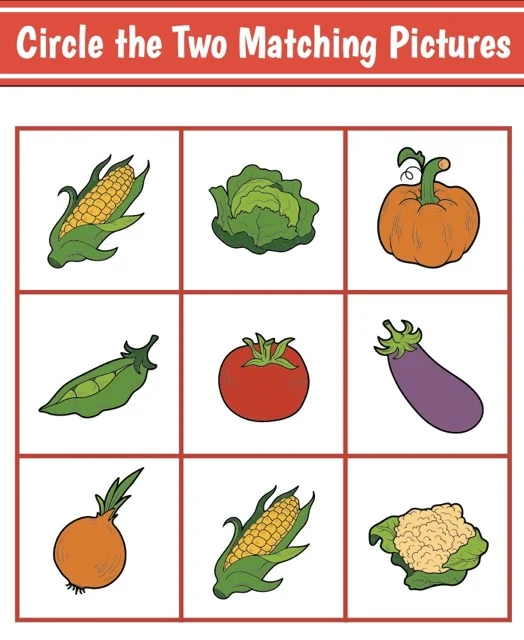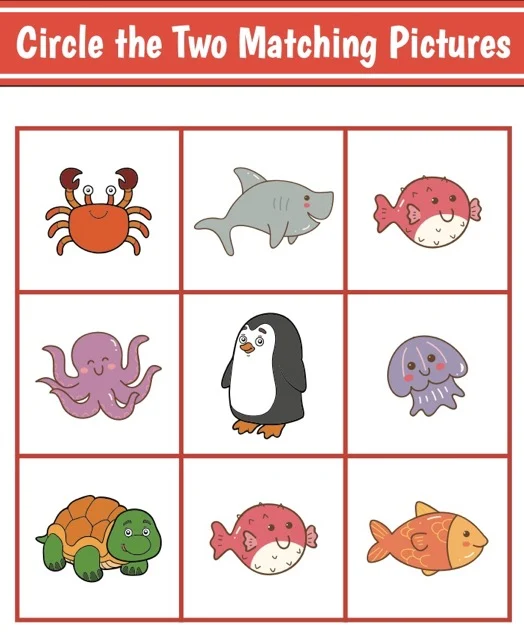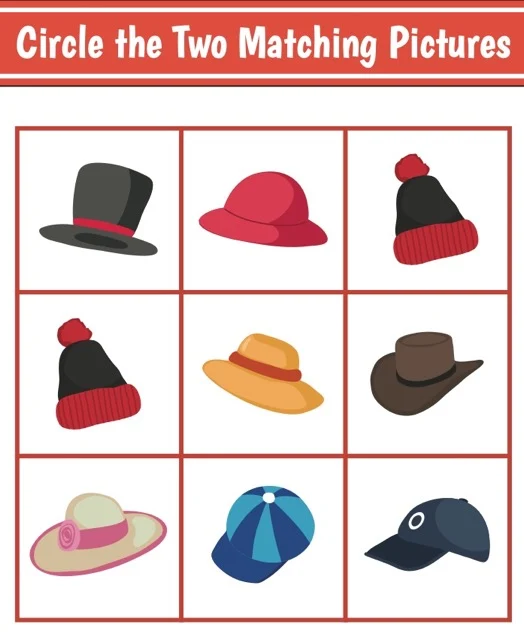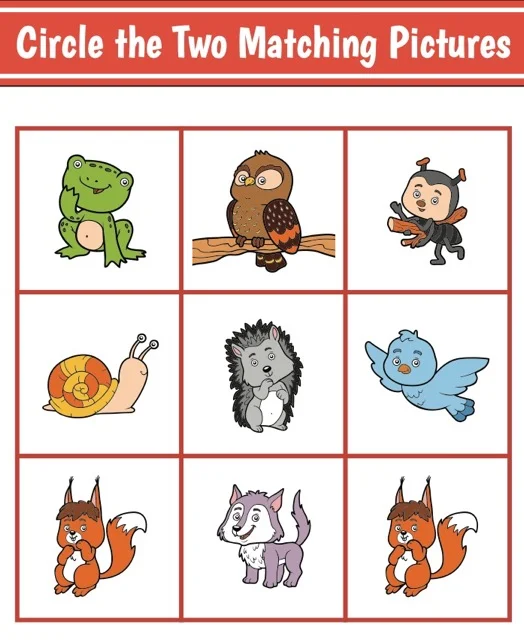Matching Picture Activities for Children
Three sources explore matching picture activities for children. Source 1 and 2 detail the benefits—including improved visual discrimination, cognitive skills, and fine motor abilities—and various types of these activities (identical, similar, object-to-shadow, part-to-whole). Source 3 offers visual examples. The sources also discuss adapting activities for different skill levels and integrating them into various learning areas like pre-reading and math. Finally, the resources available for creating matching picture activities are explored.
Matching Picture Activities: A Comprehensive Guide
Matching Picture Activities: A Comprehensive Overview
This briefing document reviews the main themes and important facts about matching picture activities, drawing from three sources:
1.
"Matching Picture Activities for Children" (Source 1)
2.
"Matching Picture Activities: A Comprehensive Guide" (Source 2)
3.
"Testing Theme: Circle 2 Matching Pictures.pdf" (Source 3)
What are Matching Picture Activities?
Matching picture activities involve pairing identical or similar images from a set of options. As Source 1 explains, they are "simple games or exercises where individuals, typically children, are asked to identify and pair identical or similar images."
Benefits of Matching Picture Activities
Matching picture activities offer various benefits for children's development:
●
Visual Discrimination: "[Enhancing] the ability to differentiate between subtle differences in images" (Source 1).
●
Cognitive Development: Improving attention to detail, concentration, and memory skills (Source 1 & 2).
●
Vocabulary Building: Introducing and reinforcing object and concept names (Source 1 & 2).
●
Fine Motor Skills: Practicing hand-eye coordination through circling or marking images (Source 1 & 2).
Types of Matching Picture Activities
Several types of matching picture activities exist, each targeting different skills:
●
Identical Matching: Finding two exact replicas of an image. As Source 2 clarifies, "children find two exact copies of the same picture."
●
Similar Matching: Identifying images sharing key characteristics or belonging to the same category, like different fruit types. This involves identifying "images that share key characteristics or belong to the same category" (Source 2).
●
Object-to-Shadow Matching: Pairing an object with its shadow, enhancing spatial reasoning and visual perception.
●
Part-to-Whole Matching: Matching a part of an object to its complete form, developing object composition and relationship understanding.
Source 3 provides visual examples of various matching activities, including identical matching with animals, perfume bottles, airplanes, and cars. The activities demonstrate the diversity in image complexity and themes possible within this activity type.
Adapting Activities for Different Skill Levels
Matching picture activities can be adapted to suit diverse ages and skill levels:
●
Number of Choices: Starting with fewer options (2-3) and increasing them as the child progresses.
●
Image Complexity: Using simple images for beginners and introducing more intricate pictures for older children.
●
Themes: Selecting themes aligned with the child's interests to maintain engagement.
Incorporating Activities into Learning
Matching picture activities can be integrated into various learning areas:
●
Pre-reading Skills: Helping children recognize and associate images with words. Source 2 explains this helps "build their visual memory and vocabulary, crucial skills for reading."
●
Math Concepts: Teaching concepts like sorting, classifying, and counting. For example, "matching sets of objects with the same quantity, helping them learn about numbers and counting" (Source 2).
●
Theme-Based Learning: Incorporating activities into units on animals, transportation, food, or other themes.
Resources for Matching Picture Activities
Numerous resources for matching picture activities exist:
●
Printable Worksheets and Cards: Pre-made or self-created using clip art, photos, or drawings.
●
Online Resources: Websites and apps offering interactive matching picture games and printable worksheets. Source 2 advises searching "matching picture games for kids" or "matching picture worksheets" online.
Conclusion
Matching picture activities are valuable tools for promoting children's cognitive, visual, and fine motor development. They can be adapted to suit different skill levels and integrated into various learning areas, making them a versatile and engaging learning resource for educators and parents alike.
Matching Picture Activities for Children
Matching Pictures FAQ
What is a matching picture activity?
A matching picture activity is a simple game or exercise where individuals, typically children, are asked to identify and pair identical or similar images from a set of options.
What are the benefits of matching picture activities for children?
Matching picture activities offer several developmental benefits for children, including:
●
Visual discrimination: Enhancing the ability to differentiate between subtle differences in images.
●
Cognitive development: Improving attention to detail, concentration, and memory skills.
●
Vocabulary building: Introducing and reinforcing the names of objects and concepts depicted in the pictures.
●
Fine motor skills: Practicing hand-eye coordination and control when circling or marking matching images.
What age groups are matching picture activities appropriate for?
Matching picture activities are suitable for a wide range of ages, starting from toddlers to preschoolers and early elementary students. The complexity of the images and the number of choices provided can be adjusted to match the child's developmental level.
What are different types of matching picture activities?
There are various formats for matching picture activities:
●
Identical matching: Finding two exact replicas of the same image.
●
Similar matching: Identifying images that share key characteristics or belong to the same category (e.g., matching different types of fruits).
●
Object-to-shadow matching: Pairing an object with its corresponding shadow.
●
Part-to-whole matching: Matching a part of an object to its complete form.
How can matching picture activities be adapted for different skill levels?
●
Number of choices: Start with fewer options (e.g., 2-3) and gradually increase the number as the child's ability improves.
●
Image complexity: Use simple, clear images for beginners and introduce more detailed or intricate pictures for older children.
●
Themes: Select themes that align with the child's interests to maintain engagement.
What materials are needed for matching picture activities?
Matching picture activities typically require printed worksheets or cards with images. You can find pre-made resources online or create your own using clip art, photos, or drawings. Markers, crayons, or stickers can be used to mark the matching pictures.
How can matching picture activities be incorporated into learning?
●
Pre-reading skills: Matching pictures can help children recognize and associate images with words.
●
Math concepts: Use matching pictures to teach concepts like sorting, classifying, and counting.
●
Theme-based learning: Incorporate matching picture activities into units on animals, transportation, food, or other themes.
Are there online resources available for matching picture activities?
Yes, there are numerous websites and apps that offer interactive matching picture games and printable worksheets. Search for "matching picture games for kids" or "matching picture worksheets" online.
Matching Picture Activities: A Comprehensive Guide
Matching Picture Activities Study Guide
Quiz
Instructions: Answer the following short-answer questions in 2-3 sentences each.
1.
What are two key benefits of matching picture activities for children's development?
2.
Describe the difference between "identical matching" and "similar matching" in picture activities.
3.
How can the complexity of matching picture activities be adjusted to suit different age groups?
4.
Beyond visual skills, what other areas of learning can matching picture activities support?
5.
List three different types of matching picture activities besides "identical matching."
6.
What basic materials are typically needed to conduct matching picture activities?
7.
Suggest one way to incorporate matching picture activities into a lesson about animals.
8.
Explain how matching picture activities can help with pre-reading skills.
9.
Where can educators and parents find pre-made resources for matching picture activities?
10.
Provide an example of how matching picture activities can be used to teach a math concept.
Quiz Answer Key
1.
Two key benefits are enhancing visual discrimination, allowing children to notice subtle differences in images, and improving cognitive skills like attention to detail and memory.
2.
In "identical matching," children find two exact copies of the same picture. In "similar matching," they identify images that share key characteristics or belong to the same category, like different types of fruit.
3.
Complexity can be adjusted by the number of choices provided, the complexity of the images used, and selecting themes that align with the child's interests and developmental level.
4.
Matching picture activities can support vocabulary building, fine motor skill development through circling or marking, and mathematical concepts like sorting and classifying.
5.
Three types are "similar matching," "object-to-shadow matching," and "part-to-whole matching."
6.
Typically, you need printed worksheets or cards with images. Markers, crayons, or stickers can be used for marking matches.
7.
You could use a matching activity where children match pictures of animals to their corresponding habitats or young.
8.
Matching pictures can help children recognize and associate images with words, building their visual memory and vocabulary, crucial skills for reading.
9.
Pre-made resources are available online on various websites and educational apps. Searching for "matching picture games for kids" or "matching picture worksheets" will yield many results.
10.
You could use a matching activity where children match sets of objects with the same quantity, helping them learn about numbers and counting.
Essay Questions
1.
Discuss the role of matching picture activities in promoting cognitive development in young children. Provide specific examples to support your points.
2.
Explain how matching picture activities can be adapted and differentiated to meet the needs of diverse learners, including those with learning challenges or disabilities.
3.
Analyze the effectiveness of using matching picture activities as an assessment tool for evaluating a child's understanding of specific concepts or skills.
4.
Explore the connection between matching picture activities and the development of early literacy skills. How can these activities prepare children for reading and writing?
5.
Design a detailed lesson plan for a specific age group that incorporates matching picture activities to teach a particular learning objective. Include clear instructions, materials needed, and assessment methods.
Glossary of Key Terms
Visual Discrimination: The ability to differentiate between subtle differences in visual stimuli, such as shapes, colors, patterns, and objects.
Cognitive Development: The process of acquiring knowledge, skills, and mental abilities through experience, learning, and maturation. It encompasses areas like attention, memory, problem-solving, and language development.
Fine Motor Skills: The ability to control and coordinate the small muscles of the hands and fingers, enabling precise movements like grasping, writing, and manipulating objects.
Identical Matching: A type of matching picture activity where individuals must find two exact replicas of the same image.
Similar Matching: A type of matching picture activity where individuals must identify images that share key characteristics or belong to the same category, but are not identical.
Object-to-Shadow Matching: A type of matching activity where individuals pair an object with its corresponding shadow, promoting spatial reasoning and visual perception.
Part-to-Whole Matching: A type of matching activity where individuals match a part of an object to its complete form, developing an understanding of object composition and relationships.
Pre-Reading Skills: Abilities that lay the foundation for reading comprehension, including phonological awareness, print awareness, letter knowledge, and vocabulary.
Theme-Based Learning: An approach to education that organizes curriculum and activities around a central theme, providing a context for learning and connecting different subject areas.
























